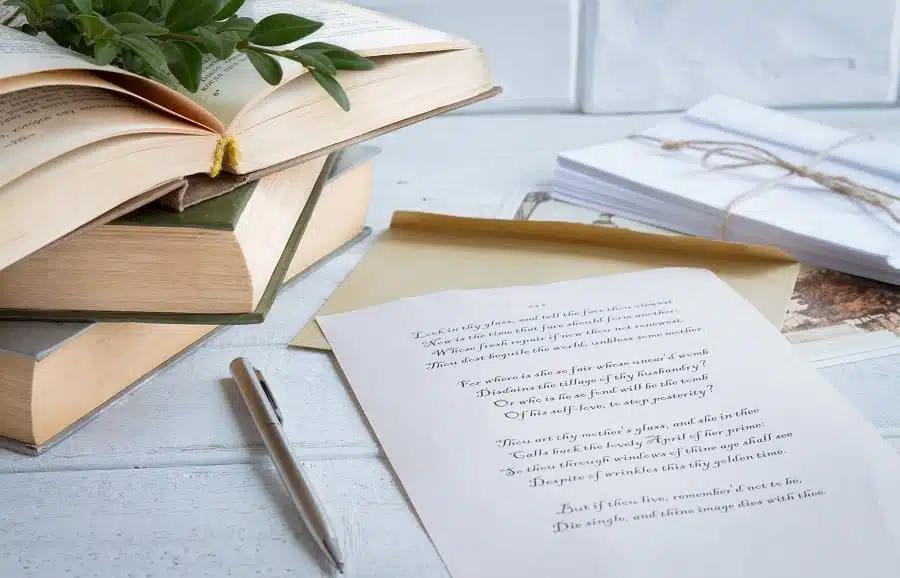Here’s how to format, punctuate, and annotate a poem:
Poetic structure hinges on stanza, rhyme, and repetition arrangement.
Poetic formatting adheres to time-honored punctuation norms.
Poetic annotating enhances comprehension by distilling a poem to its individual techniques.
So if you want to step up your poetry craft by mastering formatting, punctuation, and annotation, then this article is for you.
Let’s get started!
- Craft Captivating Poems: 16 Practical Steps
- Forge a Poem About Yourself: 5 Actionable Steps
- Craft a Captivating Poetry Analysis: 7 Actionable Steps
- Write Rhyming Poems: Unlock Rhyme Mastery
- Read Poems Aloud Like a Pro: 5 Proven Tactics
- Edit Poetry Like an Expert: 5 Easy Steps
- Analyze Poems: 6 Steps to Craft Meaning
- Critique Poetry with Ease: 5 Steps to Success

Format, Punctuate, and Annotate a Poem

As with any art form, there are as many ways to understand a poem as you can imagine.
However, a budding writer might want to think in technical terms.
What’s the best format for a poem?
Where should you put your punctuation?
How can you dissect your favorite poetry to learn from it?
This article will explore each of these questions and attempt to answer them.
Knowing why a poem is shaped the way it is and learning to ask meaningful questions about the poems you read and write will make you a better poet and a more critical reader.
Let’s get started.
#1 Poetic Formatting

As you might expect, poetic formatting is heavily dominated by how stanzas, rhymes, and uses of repetition are organized.
If it’s a formal poem, then the formatting step resolves itself.
A sonnet will always have 14 lines, and its rhyme scheme will be largely defined by the type of sonnet.
But what about free verse?
Free verse, despite the name, doesn’t need to be completely formless.
Skilled poets often use tricks taken from formal poetry and apply them to their free verse to create new forms unique to that specific poem.
But you shouldn’t just cobble together a random rhyme scheme.
Start by thinking about purpose.
What is the intended tone or meaning of the poem?
If the poem is supposed to represent the claustrophobic feeling of being stranded at an airport, then you could purposely make the poem itself claustrophobic, with long, unforgiving run-on sentences and non sequitur thoughts.
Or perhaps you want the speaker’s head to be running in circles. In that case, you could use a circular structure for the poem itself.
Maybe the poem repeats a set of three lines every couple of stanzas to emphasize the thought that keeps popping into the speaker’s head.
As for the rhyme scheme, think about tone.
A children’s poem has room to be light and bouncy, so several quatrains with a simple, consistent rhyme scheme might work well.

A poem about mourning might reflect the speaker’s half-hearted attempts to stay positive by only featuring rhymes rarely and then sinking back into rhythmless verse for long periods of time.
To put it simply, each decision you make should have some sort of purpose.
There’s no clear-cut right answer, but you should be seriously thinking about what the poem’s shape on the page can contribute to the meaning.
As a final note: Avoid super long stanzas unless you’re certain they’re the best way to express a feeling.
Long blocks of text can discourage a reader before they even begin.
Sad to say, but it doesn’t matter how beautiful your poem is if no one gives it a chance.
#2 Punctuation and Poetry

One of the most harmful trends I’ve seen in amateur poets is this lazy mentality that a poem doesn’t even have rules.
This is especially true in today’s world, where new readers misinterpret minimalism.
But here’s the thing: Even the radically minimalist writings of poets like Rupi Kaur still have strict rules.
It’s true that she doesn’t typically punctuate her poetry. But she also avoids contractions because they wouldn’t work well without punctuation.
She consistently keeps her line lengths short of making sure they won’t get confusing.
She, like many other contemporary poets, invented her own rules. That doesn’t mean there aren’t any rules.
The key difference between poetry and prose is that you choose the rules.
The most traditional way to punctuate a poem is to follow conventional wisdom.
You place the periods, commas, and such where they would normally go in a sentence.
The only difference is that you insert line breaks in meaningful moments, usually after an image or thought you want to emphasize.
Here’s a quick example:
Though I write not in prose,
still, like a pro, I chose
to keep to the old ways.
Poetry still respects form,
on this and all days.
Note that if you write out the above poem without line breaks, it’s a grammatically correct set of two sentences, with just a few flourishes to set it apart.
“Though I write not in prose, still, like a pro, I chose to keep the old ways.
Poetry still respects form, on this and all days.”

Don’t assume that you don’t need to learn about dependent and independent clauses just because you’re a poet.
Suppose you’re not willing to master conventional grammar.
In that case, you’ll never develop the expertise required to break it in useful and meaningful ways.
After you master the traditional approach, using grammar just as you would in prose, that’s when you’ll be in a good position to make your own rules as you go along.
Perhaps you’ll write a poem that’s almost proper but is purposely devoid of all commas to simulate a person rambling until they run out of breath.
Perhaps you’ll ban yourself from using nouns to see how much you can accomplish with verbs.
Not every ruleset you come up with will end with a good poem, but the rules you make for yourself should come from a place of experience and purposeful thought.
So, whether you like it or not, start out by initially following the basic grammar rules.
Master the art of the line break before you start experimenting with any other ruleset, learning to end your lines on meaningful thoughts that matter, not randomly or on forced rhymes.
Master the old rules first so that you’ll be more qualified to make your own later.
#3 Annotating Poetry

This is admittedly more about analyzing poetry than it is about writing your own.
Still, the two are deeply intertwined pieces of the craft.
Knowing how to break a poem apart into its individual techniques is a critical skill that will advance your understanding of poetry in general.
Annotation is essentially the act of marking up a poem you might love with your own commentary and thoughts.
The best approach is to think as though you’re a teacher writing comments on a student’s paper.
Look for things to circle, underline, and add comments to with an asterisk.
Mark up the poem in a way that makes sense visually, setting internal standards for how you use each marking.
Maybe a circled phrase means that you found it too confusing and obtuse.
Maybe an underline means you thought that part of the poem was especially strong.
Use your markings in a consistent way that means something to you.
One popular approach that always works is to do several different readings, thinking in a different mindset each time.

Here’s a quick list of suggestions:
- Read it normally a few times first. Just get used to the poem.
- Do a full read looking for parts that confused you. Circle them and leave comments in the margins or anywhere that they’ll fit on the page. Write out the questions you would ask the poet about these confusing lines. Suggest alternative word choices.
- Next, look for your favorite parts. Underline them and quickly write what you liked about that line nearby. Pretend you’re a teacher praising your student. “Excellent word choice!” “Extremely relatable!” Write whatever you sincerely think about the line.
- Finally, do a technical reading. I advise doing this last. Use letters to signify the rhyme scheme that was used. Count syllables to see if a few lines are unusually short or long. Take note of any instances of alliteration, assonance, or other poetic techniques you’re familiar with.
Whether you’re annotating a friend’s poem to come up with meaningful feedback, analyzing your favorite writer’s work to try to figure out how they do it, or looking over your own poetry for areas to improve, annotation is a fruitful exercise for new writers.
Do not underestimate the value of critical thinking as you set out on your own poetic path.
- Craft Captivating Poems: 16 Practical Steps
- Forge a Poem About Yourself: 5 Actionable Steps
- Craft a Captivating Poetry Analysis: 7 Actionable Steps
- Write Rhyming Poems: Unlock Rhyme Mastery
- Read Poems Aloud Like a Pro: 5 Proven Tactics
- Edit Poetry Like an Expert: 5 Easy Steps
- Analyze Poems: 6 Steps to Craft Meaning
- Critique Poetry with Ease: 5 Steps to Success
